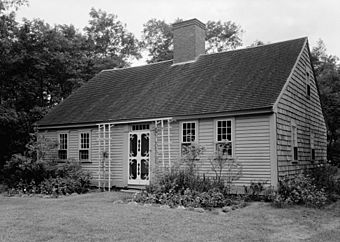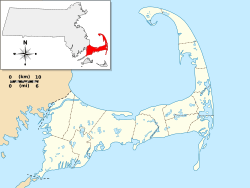Atwood–Higgins Historic District facts for kids
|
Atwood–Higgins Historic District
|
|

Photo from a 1959 HABS survey
|
|
| Nearest city | Wellfleet, Massachusetts |
|---|---|
| Area | 24 acres (97,000 m2) |
| Built | 1730 |
| Architectural style | Colonial |
| NRHP reference No. | 76000154 (original) 10000508 (increase) |
Quick facts for kids Significant dates |
|
| Added to NRHP | July 30, 1976 |
| Boundary increase | July 28, 2010 |
The Atwood–Higgins Historic District is a special place with a long history on Cape Cod National Seashore. It's located on Bound Brook Island in Wellfleet, Massachusetts. The most important building here is the Thomas Atwood House, which was built around 1730.
This property shows what life was like in Cape Cod during colonial times. It also shows how the area later became a popular summer vacation spot. The Thomas Atwood House was added to the National Register of Historic Places in 1976. The whole district, including other buildings, was added in 2010. You can visit the property for guided tours given by the National Park Service during certain times of the year.
Contents
Exploring the Atwood–Higgins Property
The Atwood–Higgins property is found on the east side of Bound Brook Island. This island is in the northwestern part of Wellfleet, on the lower section of Cape Cod. The property covers about 24 acres (9.7 hectares). It includes several buildings, most of which were built by George Higgins in the 20th century.
The Historic Thomas Atwood House
The main building is a typical Cape-style house, which means it's 1-1/2 stories tall. The oldest part of the house was built in 1730 by Thomas Higgins. He was a distant relative of George Higgins. This part of the house was originally a "half house," meaning it had three sections across its front.
The Higgins family owned this property until 1805. Then, Thomas Atwood, Sr. bought it. The last person to live in the house full-time was Thomas Atwood, Jr., who was Thomas Sr.'s son. He passed away in 1873. After that, the house was empty for many years.
George Higgins and the Restoration
In 1919, George Higgins bought the house. He carefully restored it, bringing it back to life. Higgins believed the house was built in the 1600s, but records and the way the house was built show it's from the 1700s.
Besides fixing up the main house, George Higgins also built many other buildings. These included a barn, a wellhouse, a guest house, and even a small country store. He wanted the property to feel like an old, rustic farm from colonial Cape Cod. This style is called "Colonial Revival."
It became easier to develop the property when the town improved Bound Brook Island Road. This road connected the island to the mainland. George Higgins and his neighbors on the island agreed to only make changes that fit the historical look of the area.
Becoming a National Seashore Site
In 1961, the Cape Cod National Seashore was created. George Higgins gave his property to the National Park Service at that time. This made sure the historic site would be protected for everyone to enjoy.
The Thomas Atwood House was first listed on the National Register of Historic Places in 1976. In 2010, the listing was made much larger. It now included the buildings George Higgins added in the 20th century. This also recognized the important work George Higgins did to preserve the property. Today, the National Park Service offers tours of the house during certain seasons.


